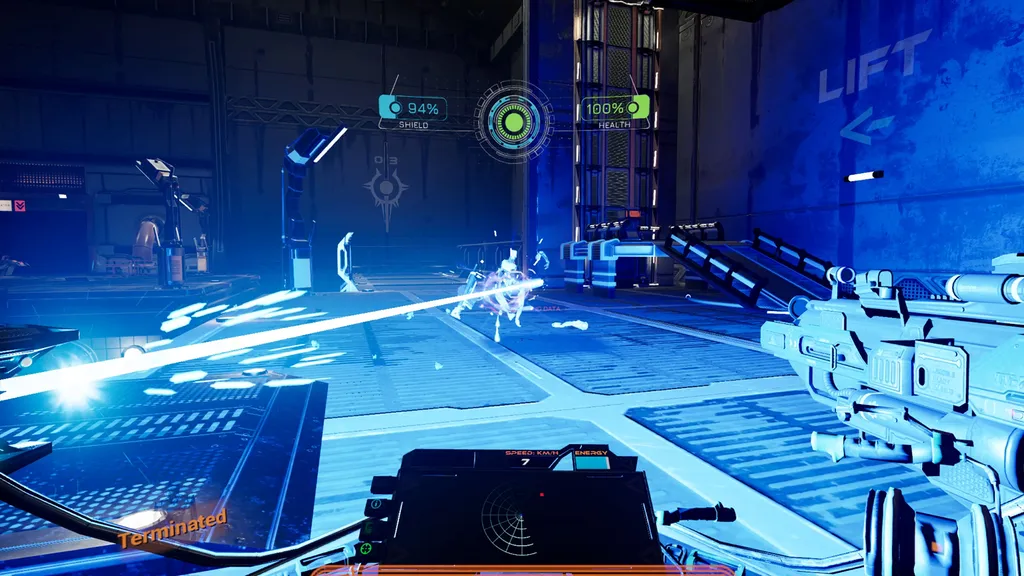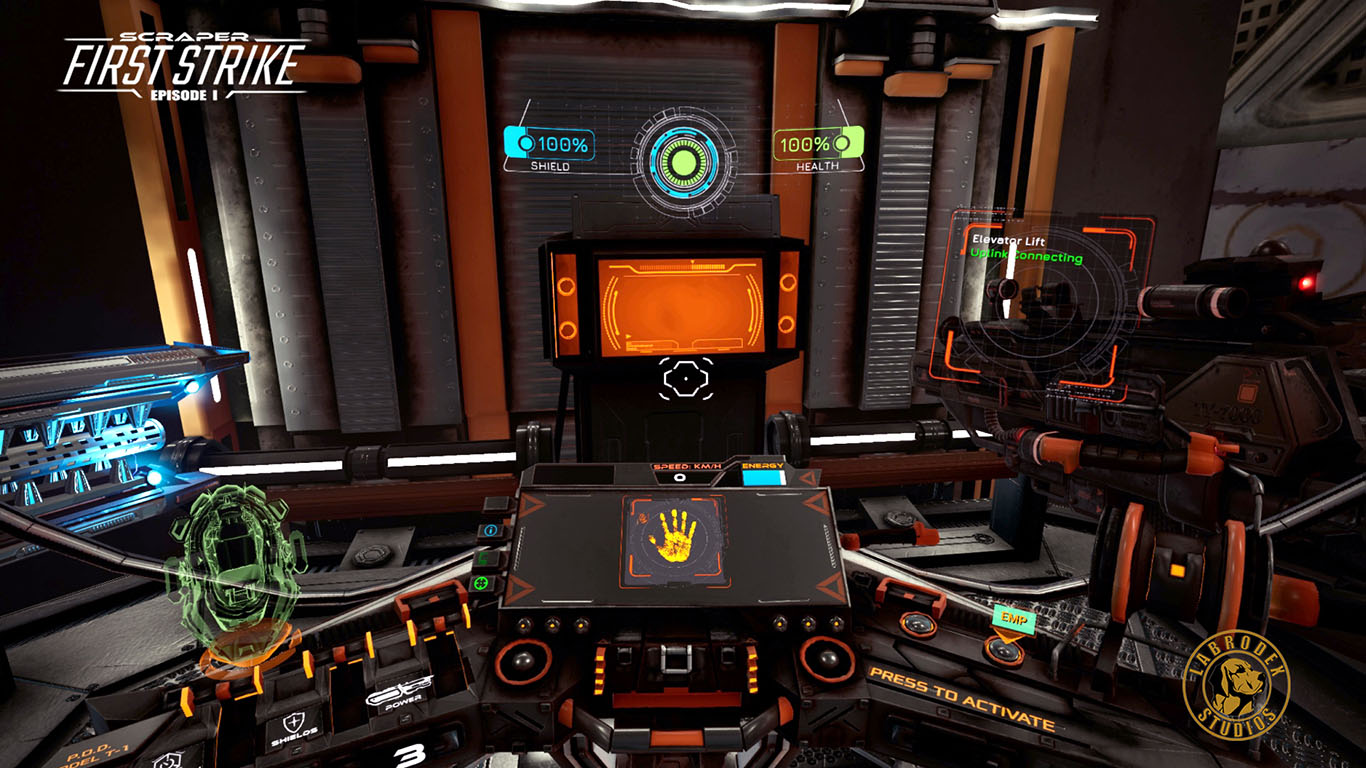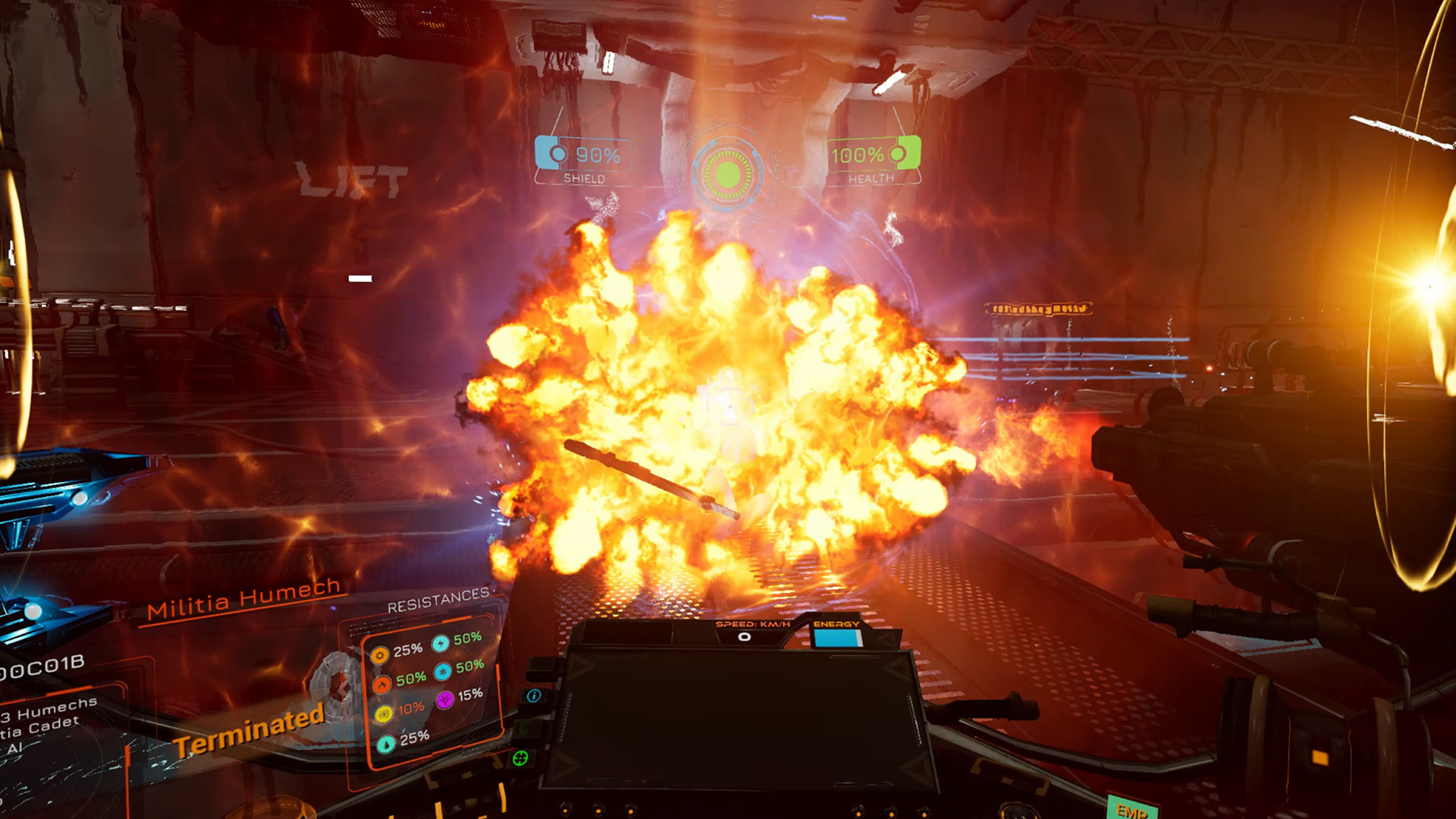In Scraper: First Strike you take on the role of mute protagonist Casey Maxwell, a hoverpod pilot who is relentlessly called upon to serve the plot for no other reason than, “You’re our only hope!” As such, you’re thrown from objective to objective without much of a motivation other than being told to do so. The narrative context boils down to these robots are bad, and we’re good, so we’re here to stop them. And you never get secondhand insight into Maxwell’s perspective other than him being a ragdoll for the plot. The few NPC characters you meet only appear to serve binary roles that motion you to move from one rote task to another with no additional interactivity, which would be fine if they were dynamic and appeared frequently enough to make you care about them. But they aren’t and they don’t. As a result, not once do you truly feel like the world comes together as a believable place, which is even more noticeable in VR.
With a beginning that directly drops you into the center of its narrative, both literally (you land on a dropship) and conceptually, it’s beyond difficult to identify with the world or its conflicts. Even past the cliffhanger ending, the story simply does not pick up in time for its beats to impart anything resembling an emotional or intellectual impact. Its heroes are heroes for no other reason than the plot commands it, and its villains are equally trite. Meanwhile it constantly refers back to, and doggedly expects you to have read through Scraper: The Rise of Cifer, the full-length prequel novel written by Ryder Wyndham; where virtually all of the game’s world-building has been swept into.
https://www.youtube.com/watch?v=btJa6ctT7U8
And while Scraper does offer a codex and conveniently scattered bits of lore at different terminals, they do not add up to more than pieces of forgettable flavor text where the vast majority of players will have no tangible narrative foundation to build upon.
Unfortunately, Scraper’s lack of a compelling story is not eased nor forgiven by its presentation.
You play the game from inside of your hoverpod, which is essentially a moving chair with a window that everything important happens outside of. And instead of feeling like you’re maneuvering a vehicle, handling the hoverpod feels far more like you’re playing a regular 2D game with the added benefit of being able to swivel your head around and see outside.
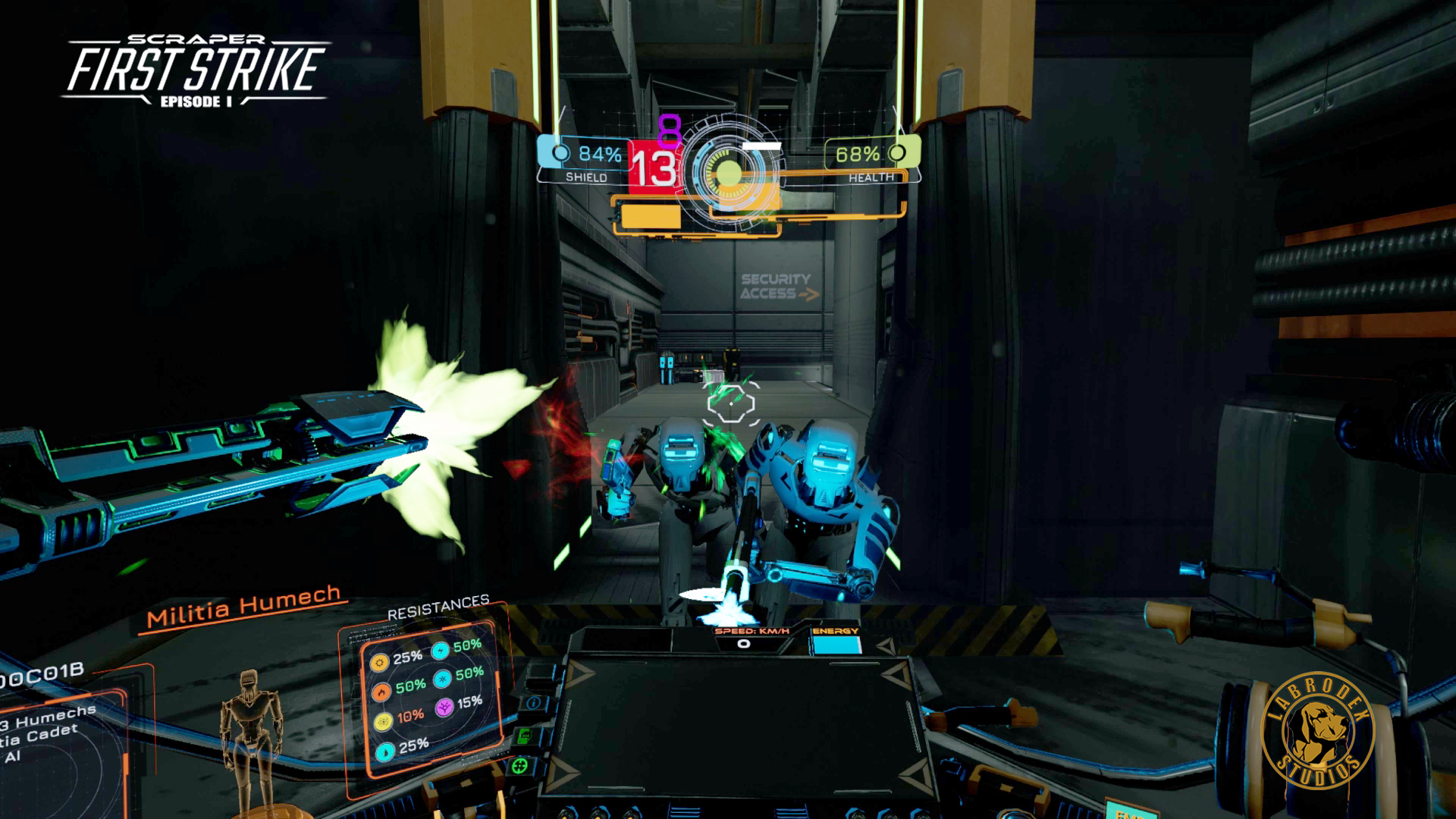
You use your thumbsticks to move around and while the comfort options are robust, Scraper can’t seem to decide whether you need to be in VR or not. Unlike a game which does vehicle controls much more decisively — such as Vox Machinae with its fully physicalized steering and acceleration toggles — Scraper posits a glaring identity issue that gets directly in the way of its own design.
At best, the auxiliary control functions within the hoverpod’s cockpit allow you to access user-interface implements like inventory menus and tooltips that you can grab and move around — on the rare occasions you need to consult them. At worst, finicky button placements for basic hoverpod actions (like healing your shields and activating your special abilities) actively frustrate otherwise frantic combat encounters.
And while it is certainly cool that you can equip different weapons on your pod’s left and right robotic arms and wield them remotely with your hands, they feel clunky — perhaps even laughably so — in practice. That said, because of their existence, you at least have some meaningful interaction with the immediate gameplay environment (happening outside of the cockpit), to remind you that moving Scraper’s campaign forward is determinant on using the full reach of your arms.
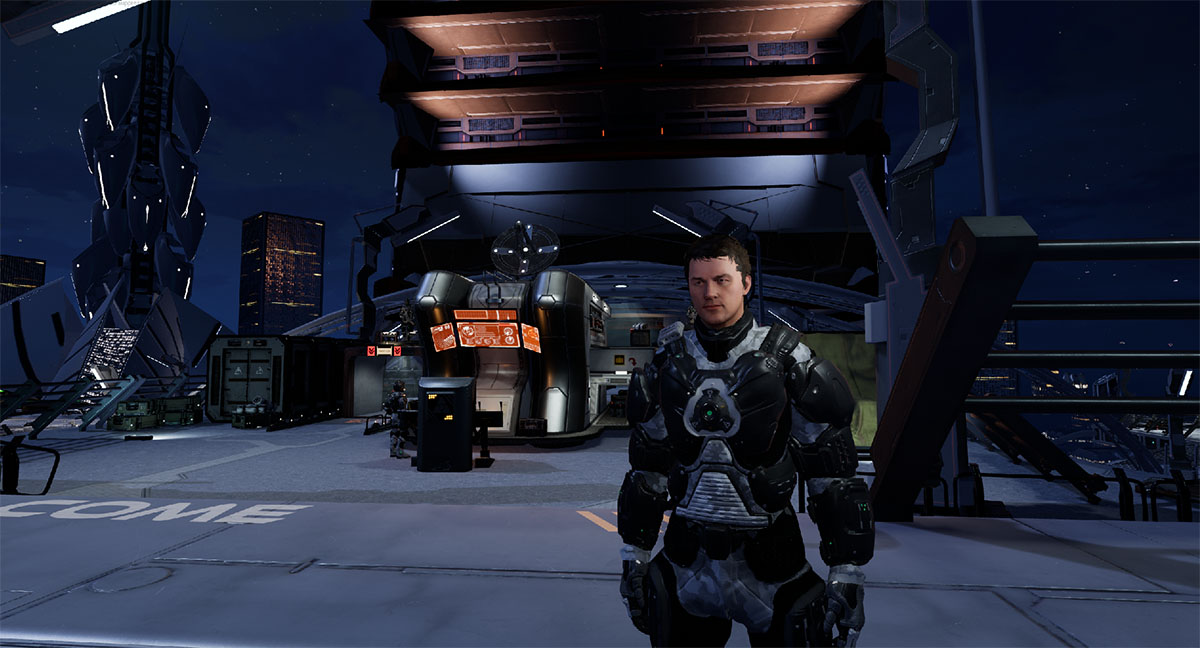
There’s plenty of shooting, looting and crafting to be done in Scraper: First Strike. You can craft up to about seven or eight different weapons to equip freely onto your robot arms, each with their own flavors of gunplay. You can only carry six at a given time, but you can carry as many permutations of the same weapon as you’d like; any extra weapons you craft can be stored in your stash. On the topic of weapons: Scraper: First Strike has everything from a shotgun to a flamethrower to a bog-standard missile launcher, but nothing pops out as original or unique. To facilitate the weapon crafting loop, you can collect schematics and components from enemies, terminals and boxes found throughout each level.
Once again though, you never directly act these things out in a way that’d be unfeasible with a keyboard or a gamepad in a 2D game. You drive over items and they’re sucked into an invisible inventory. You double-tap the lower face button on your left or right controller to reload your respective weapon. When you craft, all you’re doing is selecting options from a menu.
The charm of playing with hands in VR is thoroughly undermined when you’re given things to do but then you’re forced to do them with simple button presses while locked into a seated position. And despite its best efforts or possibly due to laziness, Scraper: First Strike frequently acts like it’s forgotten you have virtual hands. There’s actually a sequence in the game where you equip a large drill that negates the use of your weapons and activates on a trigger tap, almost entirely removing your physical body from gameplay interactions for a solid 15-20 minutes.
Meanwhile, the shooting and strafing and melee mechanics feel lackluster from a pure shooter perspective. Don’t get me wrong — they’re fun, but they’re fun in a basic (‘rock-paper-scissors’) sense, which is more excusable if you approach the game as an RPG rather than a shooter. But then the problem here is that Scraper simply is not an RPG at all. It has the mechanical underpinnings of an RPG, but those are never realized. Instead, it has loose RPG elements in the form of hoverpod mods that offer better stats.
Even so, that modding system is removed from the direct progression of the campaign. It’s easy to call player progression in Scraper: First Strike inconsequential or even non-existent because it only happens after you’ve tripped over it or sought it out — it lives entirely outside of the shooting and looting and crafting loop that makes Scraper more than a walking simulator.
And because the game’s paper-thin RPG-style progression happens so far off to the side (you must return to the Skydeck to purchase mods, then backtrack through a level to an engineering station to equip them to your hoverpod), Scraper lacks a consistent sense of power gain that responds to the player progressing through its campaign.
Adding to that point, if you’re expecting a long, narrative-focused game to chip through over the holidays, Scraper: First Strike won’t actually give you more content than SUPERHOT or Robo Recall. Each of its six total levels offer no more than two or three exercises in moving from place to place, pressing a button to complete a simple action, and trying not to die between point A and point B. And without a compelling story to guide Maxwell through these sequences, you end up feeling like you’re pressing buttons for no reason other than to kill time. The randomized combat encounters which make up the meat of Scraper’s gameplay are self-gratuitous, leaning heavily on wave after wave of swarming bullet sponge enemies with minimal recourse.
These combat encounters might even be interesting if enemy AI weren’t always doing one of either two things: moving directly at you while attacking, or standing in one place while attacking an objective you’re supposed to defend. Unfortunately, they are too repetitive to maintain interest even as the game introduces tougher enemies in its later levels.
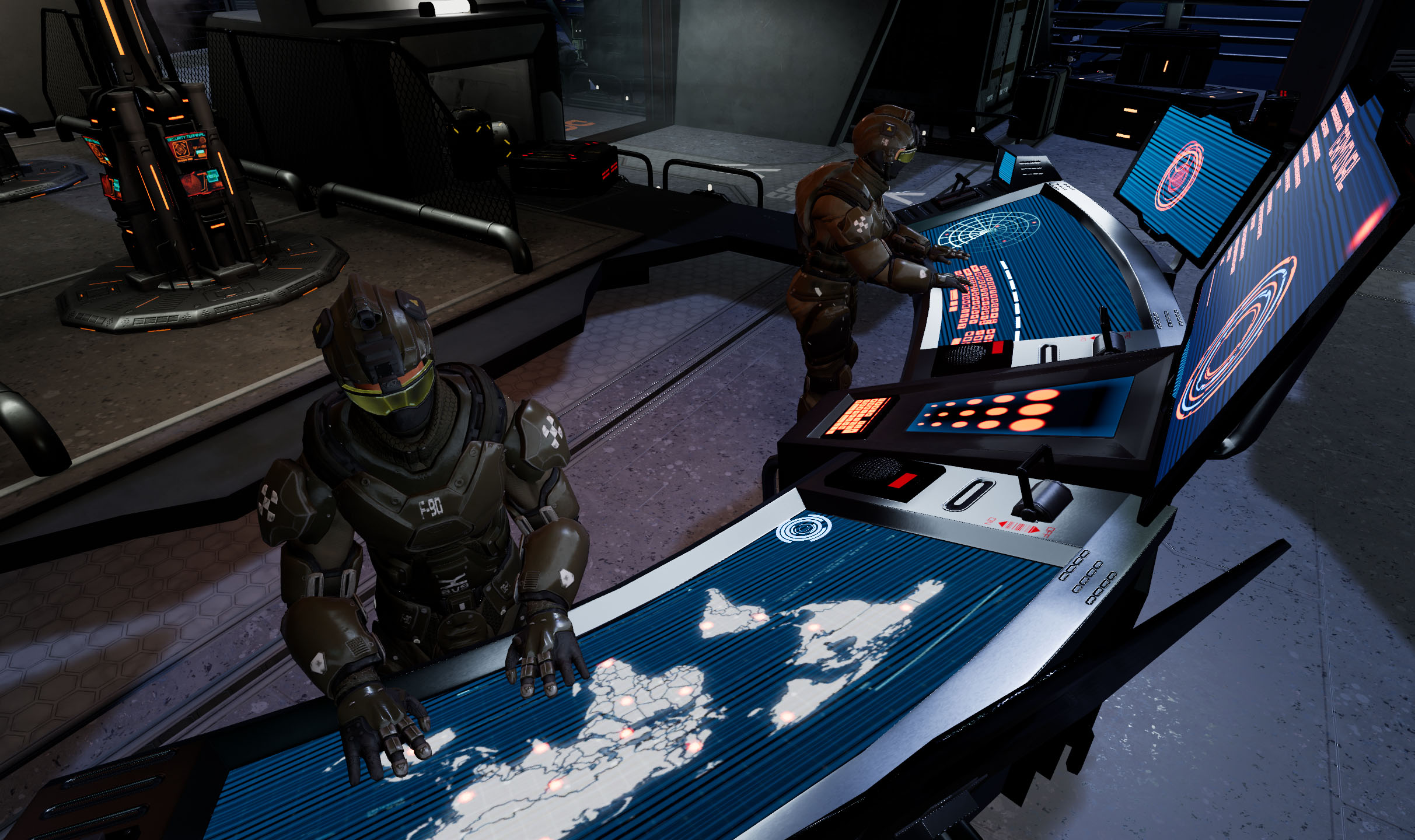
Often you can find yourself dying because you walked in the wrong direction and/or were unfortunate enough to run into the wrong batch of random encounters — an event which can most annoyingly occur while en route to upgrade your mods.
This is partially because you can’t actually heal your hoverpod’s hull without returning to a separate, remotely placed repair station. During combat, you can only perform a quick recharge of your shields, an action that sets off an inconveniently lengthy reset timer during which you’re at the mercy of any enemies that manage to cluster around you.
At first, these punishing design ethics come across as a challenge to manage your resources. But you never quite catch up with the sharp spikes in difficulty to where Scraper: First Strike feels fair or balanced. And because your cockpit’s most critical functions are arranged in a way that distract from Scraper’s thumbstick-centric strafing-n-shooting, you end up fumbling to death more often than there’s an actual challenge to overcome.
Adding salt to the wound, autosaves are few and far between, and the game frequently blocks you from manually saving during various sequences. If it wasn’t already suspect that Scraper: First Strike is using difficulty spikes to pad its length, each of its three boss battles come equipped with unavoidable attacks and unreasonably high health bars, dragging you beyond simply wanting them to be over with and leaving you with only twinges of satisfaction when you finally defeat them through what feels like sheer luck. Take into account that three and a half hours of my seven hour playthrough on Medium difficulty consisted of dying and reloading because of these issues.
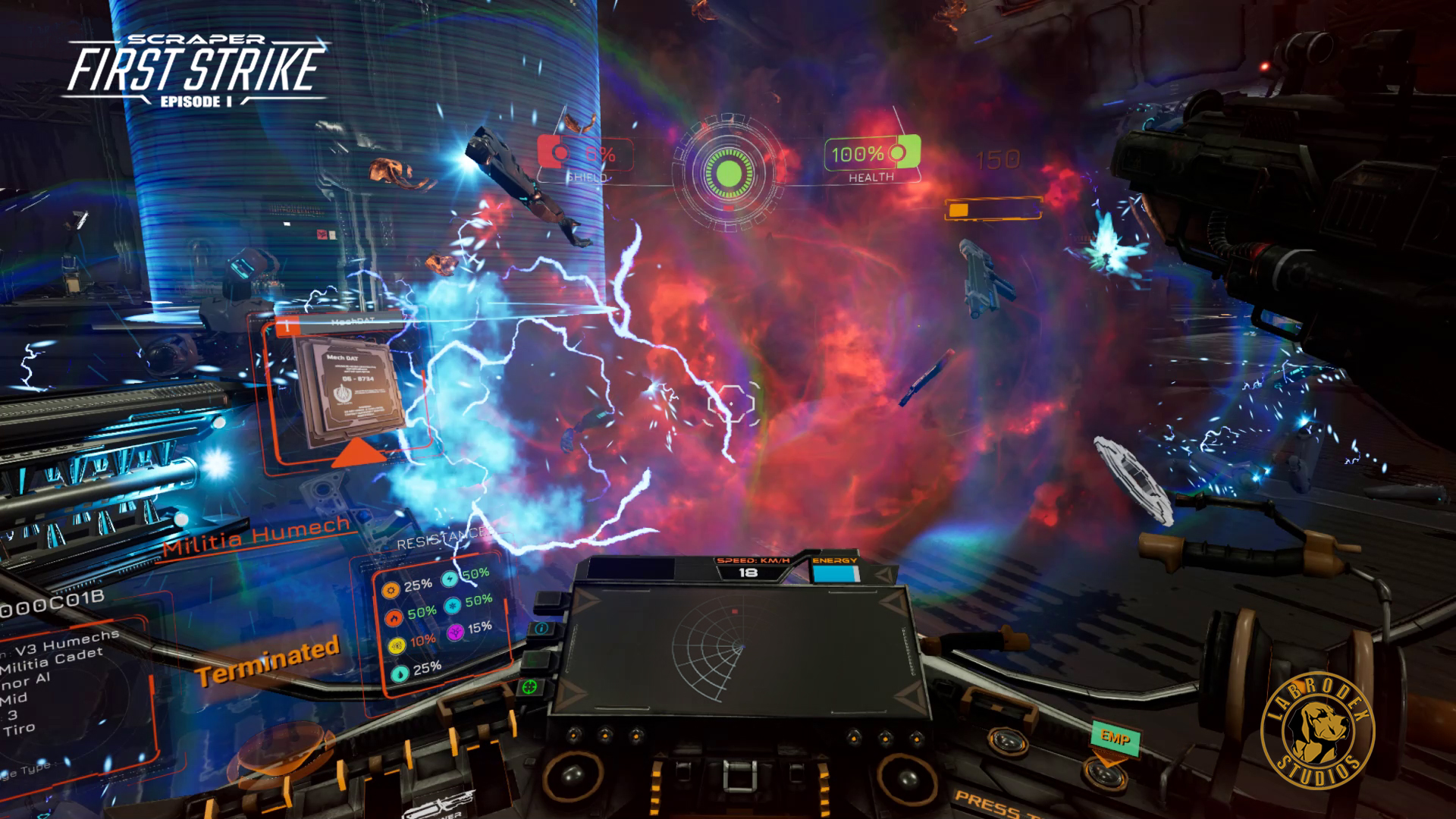
Scraper: First Strike probably isn’t the first foray into VR that Labrodex Studios hoped it would be. It doesn’t take itself anywhere seriously enough to offer mechanical depth or robustness of content, yet it takes itself far too seriously to let you relax and have fun in its world. And it’s no small fact that it desperately lacks the soul and personality of games like Borderlands or Deus Ex that it initially appears to tease inspiration from.
What I did truly enjoy about Scraper: First Strike was the beautifully orchestrated soundtrack by Winifred Phillips. Each piece is very well done but often carries a level of grandiosity that feels incompatible with the pacing and scale of events actually happening inside the game. The main menu is the only place where Scraper’s soundtrack actually matches what you see on the screen; ambient and mysterious with a sci-fi tinge reminiscent of Mass Effect’s primary Citadel hub.
At the end of the day, however, this isn’t to say that Labrodex should throw in the towel. Scraper is intended to be episodic, with progress carrying over from iteration to iteration. There are multiple assets that exist in Scraper: First Strike that are independently great. For example, the graphical fidelity and PC optimization have a AAA tightness to them which is still uncommon for many new VR releases, even if the underlying art direction leaves something to be desired. And if nothing else, I feel like at least the atmospheric soundtrack stands out — even when it fails to add anything to gameplay. If Labrodex takes this criticism seriously and uses it to their benefit, they can still steer the IP into a territory where players are given a reason to participate.
Scraper: First Strike is a game that initially promises so much, yet never makes good on any of its promises. It offers the most basic mechanical trappings of what could later become a linear action RPG, yet never uses any of its design foundation for means greater than rote tasks and wave shooter combat. And while it continuously implies its intentions to segue into a larger narrative, it never comes close to giving you a reason to care.
Scraper: First Strike is now available on Steam for $29.99 with support for Rift, Vive, and Windows VR. Read our Game Review Guidelines for more information on how we arrived at this score.

